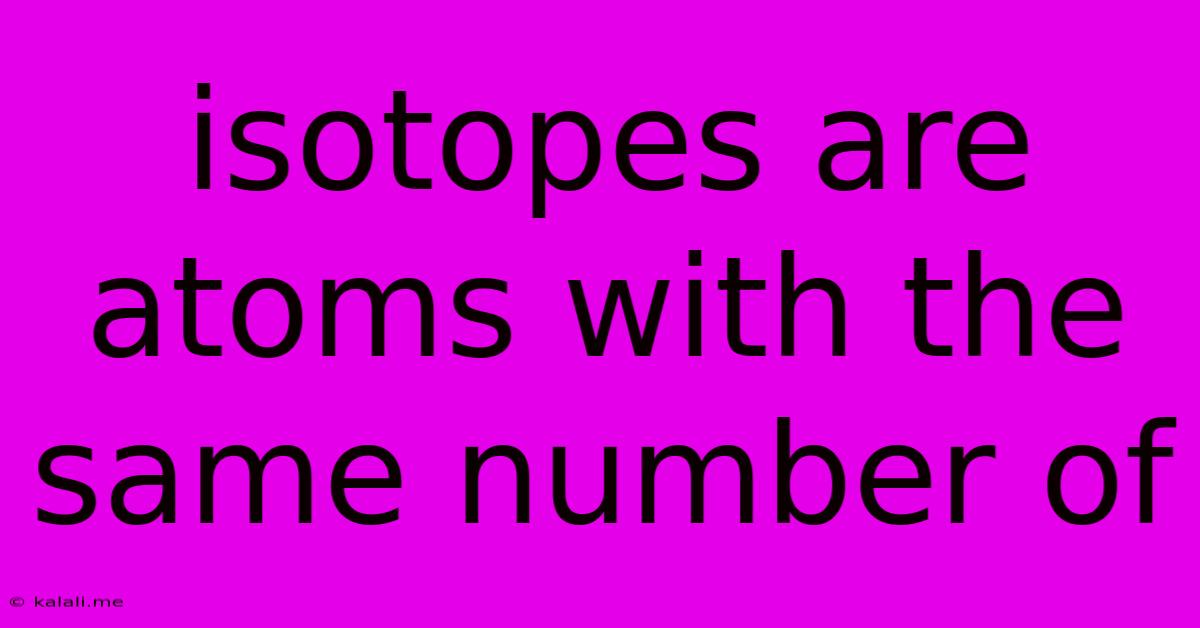Isotopes Are Atoms With The Same Number Of
Kalali
Jun 14, 2025 · 3 min read

Table of Contents
Isotopes: Atoms with the Same Number of Protons, Different Numbers of Neutrons
Meta Description: Discover the fascinating world of isotopes! Learn what makes them unique – the same number of protons but varying numbers of neutrons – and explore their diverse applications in science and medicine.
Isotopes are atoms of the same element that have the same number of protons but differ in the number of neutrons. This subtle difference in neutron count significantly impacts their properties and applications, making them crucial in various fields. Let's delve deeper into understanding these atomic variations.
Understanding Atomic Structure: Protons, Neutrons, and Electrons
Before we explore isotopes, let's refresh our understanding of atomic structure. An atom consists of a nucleus containing protons and neutrons, orbited by electrons. The number of protons defines the element; for example, all atoms with one proton are hydrogen, while those with six protons are carbon. The number of electrons determines the atom's chemical behavior, usually equal to the number of protons in a neutral atom. Neutrons, on the other hand, contribute to the atom's mass but not its chemical properties.
What Makes Isotopes Different?
Isotopes of a given element are identified by their mass number, which is the sum of protons and neutrons. Since the number of protons remains constant for a given element, the variation in mass number solely stems from the differing number of neutrons. For instance, carbon-12 (¹²C) has six protons and six neutrons, while carbon-14 (¹⁴C) has six protons and eight neutrons. Both are isotopes of carbon, but their differing neutron counts lead to variations in their stability and applications.
Isotope Stability and Radioactivity
Some isotopes are stable, meaning their nuclei remain intact indefinitely. Others are unstable or radioactive, undergoing radioactive decay to become more stable. This decay process involves the emission of particles or energy, transforming the unstable isotope into a different element or a more stable isotope of the same element. The rate of radioactive decay is characterized by its half-life, the time it takes for half of the atoms in a sample to decay.
Applications of Isotopes
The unique properties of isotopes make them invaluable in a variety of applications:
-
Carbon Dating: The radioactive isotope ¹⁴C is used in carbon dating to determine the age of organic materials. The ratio of ¹⁴C to ¹²C reveals how long ago an organism lived.
-
Medical Imaging and Treatment: Radioactive isotopes like technetium-99m are used in medical imaging techniques such as SPECT and PET scans to diagnose various diseases. Other radioactive isotopes are employed in radiotherapy to target and destroy cancer cells.
-
Industrial Applications: Isotopes are used in various industrial processes, including gauging the thickness of materials, tracing the flow of fluids in pipelines, and sterilizing medical equipment.
-
Scientific Research: Isotopes are essential tools in scientific research, aiding in understanding chemical reactions, tracking metabolic pathways, and studying geological processes.
Isotope Abundance and Average Atomic Mass
Elements naturally occur as mixtures of their isotopes. The relative abundance of each isotope determines the element's average atomic mass, a weighted average of the masses of all its isotopes. This average atomic mass is the value listed on the periodic table.
Conclusion
Isotopes, atoms with the same number of protons but varying numbers of neutrons, are fundamental building blocks with diverse applications across science, medicine, and industry. Understanding their unique properties and behaviors is crucial to advancing knowledge and developing new technologies. The differences in neutron numbers, while seemingly small, have profound implications for the stability and behavior of atoms, showcasing the intricate nature of the atomic world.
Latest Posts
Latest Posts
-
Which Of The Following Is True Regarding Blood Vessels
Jun 15, 2025
-
Which Of The Following Are Not Normally Found In Urine
Jun 15, 2025
-
What Is The Opposite Of Arrogance
Jun 15, 2025
-
How Many Drops Per Minute Is 500 Ml Per Hour
Jun 15, 2025
-
Least Common Multiple Of 11 And 10
Jun 15, 2025
Related Post
Thank you for visiting our website which covers about Isotopes Are Atoms With The Same Number Of . We hope the information provided has been useful to you. Feel free to contact us if you have any questions or need further assistance. See you next time and don't miss to bookmark.